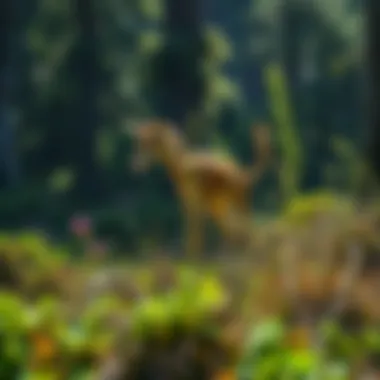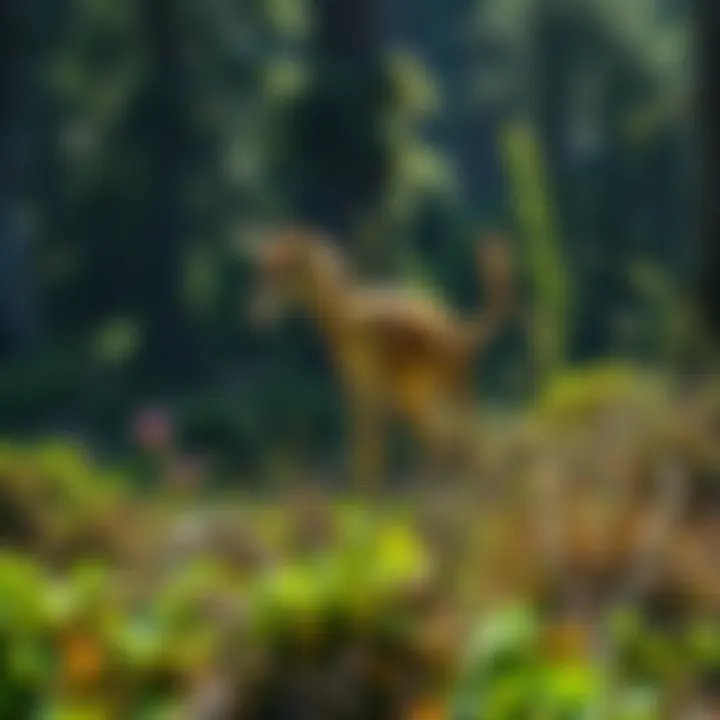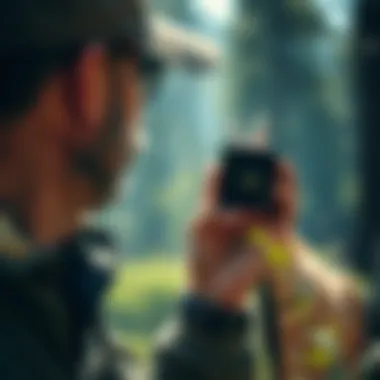Pathways to Animal Conservation: Essential Steps to Become a Conservationist


Intro
In today’s world, the call for wildlife conservation is urgent. As natural habitats face unprecedented threats due to human activity, becoming a conservationist is not just a career choice; it’s a lifelong commitment to the Earth. The road to this profession requires a blend of education, skills, and hands-on experience. Here, we’ll distill the essential pathways into animal conservation, breaking down the necessary steps and considerations.
Overview of Animal Conservation
Understanding animal conservation is like looking through a kaleidoscope; each pattern reveals a new perspective. It encompasses efforts to protect biodiversity and restore habitats under siege. With climate change, urbanization, and pollution at the forefront of challenges, conservationists must navigate a landscape requiring a multi-faceted approach.
Importance of Conservation
- Biodiversity Protection: Every species plays a role in its ecosystem. Protecting creatures, large and small, ensures stability in food webs and ecological health.
- Cultural Significance: Many communities around the world rely on wildlife for cultural, spiritual, and economic sustenance. Conserving these species helps preserve cultural identities.
- Climate Regulation: Healthy ecosystems contribute to carbon sequestration and climate stability, underscoring the valuable role that wildlife plays in combating climate change.
Key Areas of Focus
Becoming effective in conservation involves various domains, including:
- Ecological Understanding: Grasping the ambient and intricate relationships between species and their environments.
- Policy Engagement: Recognizing how policy shapes conservation efforts and participating in advocacy for effective wildlife laws.
- Community Involvement: Engaging local populations as key partners in conservation initiatives and respect local traditions.
"Conservation is a state of harmony between men and land." – Aldo Leopold
Skills Required for Conservationists
Besides formal education, specific skills can determine success in this field. Here are several crucial competencies:
- Analytical Thinking: Assessing ecological data, trends, and research is vital for understanding conservation challenges and solutions.
- Communication: Being able to convey ideas clearly helps garner community support and designs effective advocacy strategies.
- Field Skills: Hands-on experiences in wildlife monitoring, flora and fauna surveying, and habitat restoration are invaluable.
Educational Pathways
To become a qualified conservationist, you might consider pursuing degrees in fields like:
- Environmental Science
- Wildlife Biology
- Ecology
Internships, volunteer opportunities, and certifications from reputable bodies can augment formal studies by providing practical experience that is often looked for in job applications.
Engaging with Communities for Conservation
A successful conservationist must foster strong relationships with local communities. This means:
- Understanding community needs and traditions.
- Offering education on sustainable practices and wildlife protection.
- Collaborating on projects that reflect community values and address conservation goals.
By integrating conservation efforts into the socio-economic framework of communities, the chances of long-term success increase significantly.
Ending
The journey to becoming a conservationist is demanding yet rewarding. It requires a deep understanding of ecology, effective communication, and collaboration with diverse stakeholders. As conservationists, one not only works towards protecting animals but also plays an integrative role in the larger environmental picture, advocating for a sustainable coexistence with nature.
Understanding Animal Conservation
Animal conservation is a pivotal theme in maintaining the delicate balance of ecosystems and ensuring the survival of various species. This article seeks to illuminate the critical aspects of animal conservation, guiding potential conservationists through the essential steps, from understanding fundamental concepts to engaging actively in the field. By understanding animal conservation, individuals can effectively contribute to the preservation of wildlife and the habitats that sustain them.
Defining Conservation and its Scope
At its core, conservation refers to the responsible management of natural resources, aiming to protect biodiversity and foster a sustainable environment. This encompasses not just the preservation of individual species but also the ecosystems that they inhabit. Conservation has a multifaceted nature, as it intersects with social, economic, and ecological considerations. For instance, while protecting a threatened species may seem straightforward, it often involves navigating complex local community dynamics and economic implications.
It's essential to recognize that conservation efforts can vary widely depending on the local context. In some regions, conservationists might focus on large-scale habitat preservation, while in others, the emphasis may be on restoring degraded ecosystems. The scope of conservation truly knows no bounds, ranging from grassroots movements to international treaties aimed at curtailing wildlife trafficking.
The Importance of Biodiversity
Biodiversity represents the vast variety of life forms within a given habitat, and its significance cannot be understated. Healthy ecosystems rely on diverse species to function optimally; each plays a role that affects others in intricate ways. Loss of biodiversity can lead to ecosystem instability, which can have cascading effects not just on the environment but also on human benefit systems such as agriculture, medicine, and clean air and water.
"Biodiversity is not a luxury; it's a necessity for nature’s resilience."
For example, the decline of a particular pollinator, like bees, can lead to decreased crop yields. When pollinators dwindle, the result is not just fewer flowers—it's a direct hit to food security. Thus, preserving biodiversity fosters healthy ecosystems that contribute to human well-being.
Key Threats to Wildlife
Wildlife faces numerous threats that jeopardize not only their existence but also the ecological balance. Among the most significant causes are:
- Habitat Loss: Urbanization, deforestation, and agricultural expansion frequently lead to the destruction of natural habitats.
- Climate Change: Alterations in climate patterns affect migration, reproduction, and food availability. Many species struggle to adapt or migrate in response to changing climates.
- Pollution: Chemicals and waste can contaminate habitats, affecting species health and disrupting food chains.
- Overharvesting: Unsustainable hunting and fishing practices lead to population declines. This, in turn, threatens not only the targeted species but those within the same ecological niche.
- Invasive Species: Non-native species can outcompete local wildlife for resources, often leading to declines or extinctions of indigenous species.
Each of these factors compounds the challenges faced by conservationists who strive to safeguard the future of our planet's wildlife. Understanding these threats is crucial for anyone looking to make a substantial impact in conservation efforts.
Education Requirements
Education is at the core of becoming a conservationist. It equips individuals with the necessary knowledge and skillset to tackle complex ecological challenges facing our planet. As conservationists are often regarded as the frontline warriors in the battle to protect wildlife and ecosystems, a solid educational foundation is essential. A focus on diverse fields allows aspirants to develop specialized skills, providing various pathways into the vast realm of animal conservation.
Relevant Fields of Study
Ecology
Ecology is the study of interactions between organisms and their environment. This discipline is paramount for understanding how ecosystems function and how different species affect one another. One of the most appealing aspects of ecology is its broad applicability across various conservation scenarios. For instance, a conservationist trained in ecology can analyze the impact of invasive species on native wildlife.
The unique feature of ecology is its emphasis on holistic approaches, meaning that it encourages looking at the bigger picture rather than just focusing on individual components. This is particularly advantageous as conservation challenges are often multifaceted, requiring a deep understanding of ecosystems. However, ecology can also have drawbacks; those in this field might find themselves grappling with theoretical models that can sometimes seem distant from real-world applications.
Wildlife Biology
Wildlife biology narrows the focus significantly to the study of animal species and their habitats. This field contributes directly to the goals of animal conservation, as it involves researching behavior, genetics, and population dynamics of wildlife. As a key characteristic, wildlife biology offers specific insight into species’ needs and threats. For those passionate about field observation and research, pursuing a degree in wildlife biology can be both fulfilling and essential.
Wildlife biology’s unique feature lies in its applied nature; researchers often engage in practical efforts that contribute to population recovery programs. The downside here, however, is that opportunities can be limited; many wildlife biology positions may require advanced degrees or specialized training, which brings a hurdle for entry-level aspirants.
Environmental Science
Environmental science encapsulates a wide spectrum of topics, from soil health to climate change. This field is crucial for conservation as it fosters an understanding of how anthropogenic activities disturb natural systems. The key characteristic of environmental science is its interdisciplinary approach, merging geology, biology, chemistry, and social sciences. It offers a comprehensive view that can be crucial for developing effective conservation strategies.


The unique aspect of environmental science is its emphasis on solutions and mitigation strategies. Students often engage in studies that deal with practical issues like pollution and habitat destruction. On the flip side, some may view this discipline as somewhat broad and less focused on animal-specific issues, which could be a disadvantage for those keen on working exclusively with wildlife.
Pursuing Advanced Degrees
Higher education plays a pivotal role in advancing a career in animal conservation. While a bachelor’s degree lays the groundwork, advanced degrees can open up more pathways and opportunities for specialized research and leadership roles in the field.
Masters Programs
Masters programs typically offer a step up in academic credentials, often allowing individuals to hone in on a specific area of interest in conservation, such as ecology specific to a geographical region or habitat type. The opportunity to work on research projects or gain field experience through these programs adds significant value.
A major characteristic of masters programs is that they often blend theoretical knowledge with practical application through internships or fieldwork, making graduates well-rounded candidates for various roles. Still, pursuing a master's requires a considerable investment of time and money, which may deter some potential candidates.
Doctoral Studies
For those looking to reach the pinnacle of academic achievement in animal conservation, doctoral studies provide a unique platform for original research that can contribute significantly to the field. Doctoral programs often emphasize the development of new theories or the advancement of existing knowledge, which is vital in developing innovative solutions to conservation challenges.
One notable feature of doctoral studies is the intense focus on specialization, allowing students to engage deeply with their chosen area. However, the journey can be long and arduous, often requiring years of dedication, which is a consideration for many who wish to enter the workforce sooner rather than later.
In summary, solid educational grounding, whether through relevant fields of study or advanced degrees, is fundamental for aspiring conservationists. Not only do these educational pathways equip individuals with pertinent knowledge and skills, but they also foster the critical thinking required to protect our planet's biodiversity for generations to come.
Essential Skills for Conservationists
Developing essential skills is fundamental for anyone aspiring to make a significant impact in animal conservation. Conservationists engage day-to-day with nature, policy development, and community involvement. Their work doesn't just hinge on passionate intentions; it requires a diverse skill set that can address various challenges in the field. Hence, understanding and honing these skills becomes crucial for navigating the complexities of wildlife protection.
Field Research and Data Collection
Field research constitutes the backbone of conservation efforts. It's not enough to rely on academic theories; real-world data drives the decisions that shape conservation strategy. When conservationists venture into natural habitats, they need to methodically gather data on species populations, habitats, and behaviors. This involves using techniques like camera trapping for tracking wildlife movements or employing geographic information system (GIS) tools to map out ecosystems.
The art of data collection extends beyond mere numbers; it involves recognizing patterns and anomalies in the ecosystem. For instance, if a population of bears begins retreating from areas they traditionally inhabited, it can indicate significant environmental shifts or habitat loss. Having a sharp eye for such details can make all the difference. As a conservationist, it's vital to be equipped with both the technical prowess to use advanced tools and a good dose of patience to observe wildlife behavior in its natural habitat.
"Data tells the story of nature, revealing truths often overlooked."
Analytical Skills in Ecology
Analytical skills are paramount for any conservationist. Once data is collected, the real challenge lies in interpreting it correctly. Analyzing ecological data can unearth crucial insights regarding not only individual species but entire ecosystems. Understanding interspecies relationships, ecosystem health, and the effects of human intervention helps conservationists construct sound strategies.
Consider this: two comparable species living in adjacent ecosystems might react differently to climate change. Analytic skills enable conservationists to break down such complex scenarios using statistical methods and ecological models. Framing questions around these findings leads to actionable pathways for conservation decisions. Moreover, learning how to utilize software tools that analyze statistical data is also beneficial. Whether using R or Python for data analysis, having these capabilities sets a conservationist apart.
Communication and Advocacy Abilities
Effective communication is the glue that holds conservation efforts together. A conservationist must translate complex findings into understandable language for non-experts. This skill is vital not just within academic circles but also when engaging with local communities, stakeholders, and policymakers. The capacity to relay scientifically grounded information clearly and persuasively can galvanize support for vital projects.
Moreover, advocacy isn't merely about conveying data; it's about storytelling. Crafting narratives that resonate with people can inspire change. For instance, when discussing the plight of orangutans affected by deforestation, personal stories and visual media can evoke emotional responses, motivating people to become involved. Likewise, collaborating with media outlets or engaging on platforms like Reddit or Facebook can exponentially amplify a conservationist's reach and effectiveness.
In summary, the essential skills for a conservationist—be it field research and data collection, analytical prowess, or adeptness in communication—are interlinked. They enable the translation of passion for wildlife into actionable conservation efforts. Each skill plays a significant role in conveying urgent needs regarding animal populations while fostering an environment conducive to change.
Gaining Practical Experience
Gaining practical experience is crucial for aspiring conservationists. In the realm of animal conservation, theoretical knowledge about ecosystems, wildlife behavior, and environmental policies forms the foundation. However, without hands-on experience, this knowledge can remain abstract and untested. Practical experience bridges the gap between theory and application, allowing conservationists to apply their learning in real-world scenarios.
The field of conservation can be intense and complex, where the stakes are high. Experienced professionals often say that nothing can substitute the lessons learned in the field. Working directly with wildlife enhances one’s understanding of animal behavior, ecological interactions, and the challenges faced in conservation efforts. Additionally, engaging in practical experiences sharpens a range of skills from problem-solving to teamwork, which are essential for success in this field.
Internships and Volunteer Opportunities
Internships and volunteer opportunities are often the first stepping stones into the world of conservation. Many non-profit organizations and governmental bodies provide internship programs aimed at students and recent graduates. These programs frequently offer a mix of administrative work, field research, and public outreach. They immerse budding conservationists in the daily operations of conservation work and provide a space to learn from seasoned professionals.
Here are some benefits of taking on internships and volunteering:
- Real-World Experience: Interns get to engage directly with wildlife, sometimes even participating in tagging and monitoring species.
- Networking: This is a prime opportunity to build relationships in the conservation field, which can lead to future employment.
- Skill Development: Interns may learn specific skills like data analysis, species identification, or public presentation—talents crucial for a well-rounded conservationist.
It’s important to choose opportunities relevant to one’s interests or career goals. For example, someone interested in marine conservation might seek out internships with organizations that focus on oceanic ecosystems. Meanwhile, another individual might pursue projects related to terrestrial species, enabling them to tailor their experience.
Fieldwork and Research Projects
Fieldwork and research projects present a deeper dive into the practice of conservation. These are not merely tasks but are often complex projects that can span months or even years. Participating in fieldwork requires stamina, patience, and a genuine passion for nature. Whether it’s tracking endangered species, conducting habitat assessments, or implementing conservation strategies, fieldwork allows conservationists to contribute to meaningful research that informs future practices.
As vital as internships are, the sheer scope of fieldwork and its diversity cannot be overstated:
- Data Collection: Field research involves gathering data from various ecosystems, contributing to vital databases that can guide policy.
- Problem Solving: Out in the field, conservationists often face unexpected challenges, requiring quick thinking and adaptability. These experiences enhance critical thinking skills.
- Contribution to Science: Research projects can lead to publications, thereby influencing the broader scientific community and conservation policies.
In sum, gaining practical experience through internships and fieldwork is the linchpin for anyone considering a career in animal conservation. It not only hones essential skills but also prepares individuals to tackle the many challenges that come with protecting our planet's biodiversity.
"The best way to find yourself is to lose yourself in the service of others." — Mahatma Gandhi
In the realm of conservation, that often means serving the earth and its inhabitants, a task that can only truly be understood when stepped into with both feet.
Networking in the Conservation Field
Networking plays a vital role in the journey toward becoming a conservationist. Building relationships with diverse stakeholders in this multidimensional field can open doors that education alone may never unlock. The value of networking transcends mere connections; it fosters collaboration, knowledge-sharing, and opportunity identification, all of which are crucial in tackling the complex challenges facing wildlife today.
Building Connections with Professionals
Establishing rapport with established professionals can be a game changer. Attending workshops, conferences, and seminars tailored to conservation practices is an ideal avenue for meeting others in the field. When professionals gather to share new insights, young conservationists can gain critical knowledge, understand emerging trends, and exchange experiences that enrich their own understanding and perspectives. These interactions often translate into mentorship opportunities, which bring invaluable guidance.
Tips for Building Connections:
- Be Present: Engage in discussions during events, ask questions, and participate actively. It demonstrates interest and opens pathways for deeper conversations.
- Follow Up: A quick email or message expressing gratitude for the insights shared can solidify new connections.
- Social Media Engagement: Platforms like LinkedIn are excellent for reaching out and maintaining contacts with conservation professionals.
“Networking is not about just collecting contacts, it's about planting relations.”
Joining Conservation Organizations
Becoming an active member of conservation organizations can enhance your networking efforts significantly. These organizations are not just platforms for activism; they are hubs of knowledge and support that equip aspiring conservationists with the tools needed to make a difference.
Each organization often provides resources ranging from training and workshops to internship opportunities, which can be catalysts for professional development. Being involved in groups like the World Wildlife Fund or local wildlife rehabilitation centers can lead to deeper insights into the practical aspects of conservation. It could also provide access to a body of experts whose guidance can help shape one’s career path in a meaningful way.


Benefits of Joining Organizations Include:
- Access to Resources: Organizations often provide access to research, publications, and databases exclusive to members.
- Professional Development: Many organizations offer training sessions that can refine one’s skills and knowledge.
- Volunteer Opportunities: These can serve as stepping stones to permanent roles and help you gain practical experience in the field.
In summary, networking in the conservation field is essential. It creates a web of connections that can enhance your journey, provide support, and lead to fruitful opportunities in your conservation career. Building connections with professionals and joining dedicated organizations are two key steps that can significantly empower you as you work towards your goals in animal conservation.
The Role of Policy in Conservation
In the realm of animal conservation, policy plays a crucial role that cannot be overstated. It acts as the backbone of conservation efforts, ensuring that there are legal frameworks to protect habitats, regulate activities that threaten wildlife, and promote sustainable use of natural resources. Without effective policies, the fight against the decline of biodiversity becomes significantly more challenging. By establishing clear guidelines and standards, policies help to align conservation goals with broader societal needs, balancing ecological health with economic development.
Understanding Conservation Laws
Conservation laws serve as the legal instruments that safeguard various species and their habitats. These laws can vary greatly from one region to another, reflecting the unique ecological and cultural contexts of each area. Key pieces of legislation such as the Endangered Species Act in the United States or the Convention on International Trade in Endangered Species of Wild Fauna and Flora (CITES) provide critical protections. Understanding these regulations is vital for anyone aspiring to work in animal conservation.
They define what constitutes a protected species, outline the penalties for illegal hunting or habitat destruction, and set the requirements for conservation planning. Keeping abreast of these laws requires continuous learning and engagement, as changes in political climates can lead to shifts in these regulations. Participation in workshops or discussions hosted by ecological organizations can help conservationists stay informed and proactive.
"Conservation laws are not just rules; they are the guidelines that provide the framework for responsible stewardship of our natural heritage."
Advocacy and Policy Change
Effective advocacy is an integral part of influencing conservation policy. Conservationists often find themselves at the intersection of science and politics, where they must translate complex ecological data into persuasive arguments that resonate with decision-makers. Initiatives like grassroots campaigns or working with lobbying groups can amplify voices that push for stronger laws and policies.
The importance of building a coalition cannot be stressed enough. Uniting diverse stakeholders — from local communities to scientific bodies — creates a comprehensive force for change. It’s not just about protesting or raising awareness; it's about constructive dialogue with policymakers to advance conservation agendas. Those working in conservation must develop skills in negotiation and public speaking, as these will be the tools to communicate needs and push for the necessary reforms.
In addition, participating in public consultations and providing feedback on proposed legislation can also lead to significant changes. Engaging with platforms like the International Union for Conservation of Nature (IUCN) or local conservation groups on social media can clarify how one can contribute to meaningful policy advancement.
The relentless push for policy change is often seen as a marathon, not a sprint. It requires patience, resilience, and the capacity to adapt strategies as circumstances evolve. Yet, the rewards of safeguarding wildlife through effective policy can be monumental, creating lasting impacts for generations to come.
Career Opportunities in Animal Conservation
Understanding the different avenues within animal conservation is pivotal for aspiring conservationists. Career paths in this field not only offer a way to work closely with wildlife but also contribute significantly to the sustainability of our planet. The opportunities available can cater to various interests and skill sets, and they often intersect, creating a rich tapestry of professional experiences. Knowing where to channel your efforts can make a world of difference in your impact and career satisfaction.
Non-Profit and NGO Roles
The non-profit sector is one of the backbone pillars supporting animal conservation initiatives. Organizations such as the World Wildlife Fund and Conservation International lead the charge in global conservation efforts, often needing passionate individuals to help. These positions might encompass anything from grassroots activism to high-level program management.
Key roles in this sector include:
- Conservation Biologist: Studying species populations and implementing strategies for their protection.
- Fundraiser: Crafting campaigns and grant proposals to secure funding necessary for ongoing projects.
- Environmental Educator: Developing outreach programs to raise awareness within local communities about wildlife protection.
Working with these organizations means you have an opportunity to make a tangible difference. You'd be contributing to projects like habitat restoration, species reintroduction, learning about human-wildlife conflict, and engaging with communities that interact with wildlife directly.
A role here often brings funding challenges, but the experience gained is invaluable. It offers the chance to witness firsthand the effect of your efforts while working alongside experienced professionals in the field.
Government and Research Positions
Government jobs in conservation range from local to international levels, providing a wealth of opportunities to immerse oneself in regulatory frameworks, resource management, and biodiversity protection. For instance, bodies like the U.S. Fish and Wildlife Service or state wildlife agencies require skilled individuals to enforce laws protecting species and habitats.
Common positions include:
- Wildlife Manager: Overseeing specific populations, managing land to support wildlife, and working within regulatory guidelines.
- Policy Analyst: Researching and advising on conservation policies, helping lawmakers understand the implications of regulations on wildlife.
- Ecologist: Conducting studies that inform strategies for better wildlife management and habitat conservation.
More so, research positions within universities or environmental organizations also play a crucial role in advancing conservation. By working in labs or field settings, research scientists collect data that guides effective conservation strategies. Positions in this realm often lead to publications that can inspire further studies and real-world applications in conservation.
This combination of opportunities across non-profit and government sectors contributes to a well-rounded ecosystem aimed at tackling the urgent needs in conservation today.
In summary, careers in animal conservation are both diverse and critical. Whether one prefers the hands-on approach offered by non-profits or the policy and management focus of government roles, both pathways lead towards a greater good—ensuring the future of our planet's wildlife.
Engaging the Community in Conservation Efforts
Engaging the community in conservation efforts is a vital strategy that transcends mere participation; it fosters a sense of stewardship and shared responsibility towards wildlife and natural environments. By marrying local traditions and interests with conservation initiatives, conservationists can create a cohesive and collaborative approach to safeguarding biodiversity. Community involvement can be the linchpin that holds sustainable conservation efforts together, ensuring that initiatives stick long-term.
Key Elements of Community Engagement:
- Local Knowledge: Engaging communities allows for the integration of traditional ecological knowledge with modern practices. Locals often have deep insights into their ecosystems that can enhance conservation strategies.
- Shared Benefits: When communities see tangible benefits from conservation, like improved local economies through eco-tourism, they are more likely to support conservation efforts.
- Education and Awareness: Raising awareness about the importance of conservation leads to better-informed citizens who can advocate for wildlife protection.
The benefits of such engagement extend both ways; while it enriches conservation strategies, it also empowers the community, giving them a stake in the outcomes. With their involvement, conservation efforts can pivot from being viewed as external impositions to being seen as vital, localized endeavors.
Educational Outreach Programs
Educational outreach programs serve as gateways for community engagement in conservation. These programs are not just about imparting knowledge but about nurturing a culture of awareness and proactivity regarding environmental issues. Initially, they may focus on schools, where students can learn about wildlife ecosystems and conservation issues through interactive and engaging content. This can range from classroom sessions to field trips that immerse students in their local environments.
An effective educational outreach program might include:
- Workshops on biodiversity for both adults and children.
- Guided nature walks that aim to highlight local flora and fauna, making participants more connected to their surroundings.
- Collaborations with community centers to foster inclusive conversations about conservation and its relevance.
Using compelling stories and relatable communication methods can help to spark interest. This connection is essential as it promotes conservation literacy. Furthermore, educating young people positions them as future champions for wildlife protection.
Collaborating with Local Communities
Collaboration with local communities goes beyond education; it’s about partnership. Understanding the community dynamics can lead to better conservation outcomes. When conservationists work closely with communities, they can identify shared goals and develop initiatives that are sustainable and practical.
For effective collaboration, consider the following:
- Co-Design Initiatives: Involve community members in designing conservation projects that reflect their needs and values. This inclusivity ensures that the initiatives resonate well within the community and garner support.
- Feedback Mechanisms: Create channels for community members to actively provide input on conservation efforts. This fosters transparency and trust, which is crucial for long-term success.
- Resource Sharing: Conservationists can provide resources like materials or expertise while learning in return about local practices that promote sustainability.
Collaboration can foster community-led conservation initiatives, helping to create champions who will advocate for wildlife and environmental health locally. Engaging in these partnerships transforms conservation projects into community projects, laying the foundation for shared ownership and responsibility.
"The best solutions are always found when communities, including conservationists, work side by side. Each has something invaluable to offer the other."
Through these efforts in educating and collaborating, conservationists not only build solid relationships with the communities but also deliver a more robust approach to protecting our planet’s irreplaceable resources.
Sustainable Practices and Innovations in Conservation
Sustainable practices within the conservation arena are akin to the lifeblood that nourishes a vibrant ecosystem. These approaches not only fortify our efforts in wildlife preservation but also promote a balanced relationship between nature and human activity. Embracing sustainability means adopting methods that ensure the environment is nurtured rather than exploited. This isn't just good practice; it’s imperative as conservationists face pressing environmental crises.


When we discuss sustainable practices, it encompasses a broad spectrum, including habitat restoration, responsible resource management, and community involvement. Each element plays a pivotal role in fostering biodiversity and maintaining healthy ecosystems, ultimately leading to a more sustainable future for many species at risk of extinction.
Benefits of Sustainable Practices
- Biodiversity Enhancement: Implementing sustainable practices leads to healthier ecosystems. With more robust habitats, various species have a fighting chance, ensuring genetic diversity that is essential for resilience against diseases and changes in climate.
- Community Engagement: Involving local communities fosters stewardship of the land. This creates a sense of ownership, where individuals feel responsible for their surroundings and contribute actively to conservation efforts.
- Economic Viability: Sustainable practices can boost local economies through ecotourism, providing financial incentives that encourage the protection of wildlife.
- Long-term Solutions: By integrating sustainable practices, we develop solutions not just for today but for a future where both wildlife and humans can thrive.
Integrating Technology in Conservation
The integration of technology into conservation efforts has revolutionized the way conservationists approach wildlife management and habitat protection. Technology serves as a tool that enhances data collection, increases efficiency, and promotes awareness regarding biodiversity.
One notable example is the use of drones. They soar high above forests and wetlands, offering bird's-eye views that were once out of reach. These docile machines help monitor animal populations, maps terrain changes, and assist in identifying illegal poaching activities. Remote cameras, too, have become invaluable. They allow conservationists to gather information on species behavior without disturbing their natural habitats.
Moreover, technology facilitates data analysis through advanced software. Conservationists can utilize big data and machine learning to predict environmental changes and assess the effectiveness of conservation strategies. For instance, using algorithms to analyze patterns in animal migrations can provide insights into how climate shifts impact species health.
Applications of Technology in Conservation:
- Remote Sensing: Satellite imagery can help monitor deforestation and habitat loss, enabling timely interventions.
- Genomics: Studies on genetic diversity aid in understanding the health of endangered populations, highlighting the need for conservation actions.
- Mobile Apps: Citizen science applications allow the public to report wildlife sightings, helping to track species distribution and population trends.
New Methods and Trends
In the ever-evolving field of conservation, staying ahead of the curve is essential. New methods and trends are emerging regularly, reflecting society's growing understanding of ecology and biodiversity. One trend worth noting is the adoption of nature-based solutions (NbS), which work with natural processes to address challenges like climate change while improving community resilience.
For instance, restoring wetlands not only enhances biodiversity but also acts as a buffer against flooding and purifies water supplies. This multifunctionality of conservation actions is becoming more recognized and implemented.
Another noteworthy trend is the rise of collaborative conservation efforts. By bringing together stakeholders from various backgrounds—government bodies, NGOs, private sectors, and local communities—conservation becomes more holistic. These partnerships can leverage resources, share knowledge, and maximize impact, making moves towards achieving larger conservation goals much more feasible.
Finally, the push towards increased transparency by organizations promotes accountability. For example, using blockchain technology for tracking wildlife trade ensures that conservation funds are used wisely and effectively.
"Conservation is a state of harmony between men and land." – Aldo Leopold
For further reading and resources on sustainable conservation practices, explore:
- The Nature Conservancy
- World Wildlife Fund
- National Oceanic and Atmospheric Administration
- U.S. Fish and Wildlife Service
- Ecological Society of America
Challenges Faced by Conservationists
Conservationists often find themselves navigating a maze of difficulties that can hinder their efforts to protect wildlife and restore ecosystems. Understanding these challenges is crucial, not just for those directly involved in conservation but for anyone interested in the sustainability of our planet. This section maps out the specific hurdles conservationists face, focusing on funding and resources alongside political and social obstacles that can significantly impact the effectiveness of conservation initiatives.
Funding and Resource Limitations
Funding and resource availability play a critical role in conservation efforts. Many programs rely heavily on grants, donations, and government support, which can be unpredictable and often inadequate.
- Variability in funding sources: Unlike corporate sectors where profitability can pivot funding, conservation work frequently encounters fluctuations in financial support due to changing political priorities or economic downturns. Projects may be left stranded if their financial backing dries up, forcing conservationists to abandon vital initiatives.
- Resource allocation: Limited funding can also affect the allocation of resources such as equipment for monitoring wildlife, funds for hiring specialists, or even basic infrastructural needs. For instance, a local wildlife reserve might have the technical expertise among its team but lack the necessary funds to undertake a comprehensive wildlife survey.
- Dependence on community support: Often, conservation efforts rely on local communities for funding through citizen-generated initiatives. For example, crowdfunding campaigns can bring in some revenue, yet the effectiveness and sustainability of such efforts vary widely.
The struggle for adequate funding and resources completely encapsulates the uphill battle that many conservationists encounter daily. As they aim for long-term sustainability, they must constantly engage in resource management and creative funding solutions to keep their projects afloat.
"As the tides of funding shift, conservationists often find their best-laid plans dashed, and the weight of that uncertainty is a heavy burden to bear."
Political and Social Obstacles
In addition to financial constraints, political and social obstacles complicate the conservation landscape further. Navigating this terrain requires a keen understanding of the local and global socio-political contexts.
- Regulatory hurdles: Legislation can dictate how and where conservation efforts occur. In many instances, invasive laws or lack of enforcement can slow or completely halt essential projects. For instance, legislation might protect certain species, but the red tape can hinder timely responses to threats such as poaching or habitat destruction.
- Competing interests: Conservationists often face opposition from industries that prioritize economic gain over environmental preservation. For instance, logging companies may lobby against protected forestry initiatives. This can lead to a conflict of interest where local economies clash with ecological needs.
- Public perception and engagement: The success of conservation projects often hinges on public support. If local communities do not see immediate benefits, they may become resistant to conservation measures. Misunderstanding or lack of awareness of conservation efforts can lead to community backlash, which further complicates the implementation of essential initiatives.
Addressing these political and social challenges requires conservationists to adopt a multi-faceted approach, emphasizing effective communication, collaboration with stakeholders, and advocacy to influence policy positively.
Future Directions for Animal Conservation
As we look ahead in the field of animal conservation, it's crucial to spotlight the pathways that lie before us. The future isn't merely about continuing current practices but rethinking methods and strategies to align with escalating environmental challenges. The need for forward-thinking individuals—and policies—has never been more evident. By focusing on emergent trends and the interwoven web of global collaboration, conservationists can carve more effective means to mitigate biodiversity loss and ecological degradation.
Emerging Trends in the Field
The landscape of animal conservation is rapidly evolving, driven by technology, societal awareness, and ecological demands. Here are some noteworthy trends that are significantly shaping the future of conservation:
- Use of Technology: Technologies like drone monitoring, camera traps, and Geographic Information Systems (GIS) are game-changers, allowing greater accuracy in tracking wildlife movements and mapping habitats. In addition, mobile applications are simplifying the reporting of poaching incidents or illegal activities, empowering citizens to participate in conservation directly.
- Citizen Science Initiatives: More and more, conservationists are tapping into the enthusiasm of average citizens. Engaging communities in data collection through platforms like iNaturalist or eBird allows for large-scale data gathering while simultaneously educating the public about local wildlife.
- Climate Change Mitigation Strategies: Understanding how climate change affects wildlife is paramount. Future conservation efforts must prioritize adaptive management strategies that cater to the changing climates wildlife will face, such as habitat restoration focused on climate resilience.
- Sustainable Practices: The push for sustainability is rearing its head in conservation, prioritizing not just wildlife preservation but incorporating human socioeconomic factors. This includes promoting sustainable agriculture and responsible tourism that benefits both wildlife and local populations.
In essence, these trends provide blueprints for conservationists aiming to stay relevant in the face of unyielding environmental shifts.
The Role of Global Collaboration
Collaboration across borders is no longer a luxury; it's a necessity. Nature knows no boundaries, and neither do the threats it faces. Here are some key components of effective global collaboration in conservation:
- Shared Knowledge: Partnerships between countries can foster the exchange of best practices and innovative strategies. Various global organizations, such as the World Wildlife Fund (WWF) and International Union for Conservation of Nature (IUCN), are facilitating these exchanges, pooling resources to tackle shared challenges.
- Joint Conservation Projects: Collaborative efforts can lead to bigger and bolder initiatives. For example, transboundary conservation areas, such as the Kavango-Zambezi Transfrontier Conservation Area, span multiple nations allowing for shared resources and unified management of important habitats and endangered species.
- Global Funding Mechanisms: The rise of international funds dedicated to conservation has amplified efforts globally. Programs like the Global Environment Facility (GEF) emphasize collaborative projects that benefit biodiversity across multiple nations while addressing pressing environmental issues.
"The challenges of conservation are daunting, yet working together can illuminate paths towards sustainable solutions."
Personal Attributes of a Conservationist
When it comes to conservation, beyond the educational qualifications and technical skills one possesses, personal attributes can play a pivotal role the entire journey of a conservationist. It doesn’t just boil down to the skills acquired through formal education or field experience; the heart and soul someone pours into the work makes all the difference. Therefore, taking a closer look at the essential personal attributes that a conservationist must embody can provide guidance and depth to one’s commitment to this field.
Passion for Nature and Wildlife
Passion for nature and wildlife is arguably the most critical attribute for anyone entering the field of conservation. Without this intrinsic motivation, the long hours spent in sometimes harsh environments, the disappointment in bureaucratic red tape, and the continuous fight to raise awareness can become overwhelming.
This passion often translates into a profound respect for living beings and ecosystems. When a conservationist connects on a personal level with nature, it fuels their determination to protect it. For instance, someone who dedicates weekends to volunteering at a wildlife rehabilitation center or participates in community clean-ups is likely engaging in activities driven by genuine concern for the environment. Such commitment can lead to significant breakthroughs in conservation efforts, inspiring others and building a community around shared values.
Moreover, this passion frequently blossoms into a lifelong quest for knowledge. Conservationists often become avid learners, seeking out the latest research or attending workshops to enhance their understanding of ecological dynamics. They embed themselves in the scientific community, drawing connections between their experiences and established ecological theories, thus refining their advocacy efforts. Their enthusiasm often radiates, influencing peers and newcomers alike.
“The greatness of a nation and its moral progress can be judged by the way its animals are treated.” – Mahatma Gandhi
Resilience and Adaptability
The journey of a conservationist isn’t without its share of challenges, and here’s where resilience and adaptability come into play. This field is often fraught with technical challenges, unforeseen circumstances, and sometimes discouraging results. A conservationist must navigate through projects that may not yield immediate success, and the ability to bounce back from setbacks is crucial.
Conservationists regularly face challenges such as funding constraints. Concepts that seem brilliant on paper may fail to secure the requisite financial backing, resulting in project stagnation. Those who can adapt their ideas, pivot their approach, or seek out alternative funding sources are often the ones who succeed in propelling their projects forward.
In addition, working in diverse ecosystems means dealing with ever-changing environments and community dynamics. A conservationist working in a tropical rainforest one week might shift to a dry savanna the next, requiring rapid adjustments not just in lifestyle but also in strategies. Knowledge of local fauna and flora is not always easily transferable, necessitating quick learning and flexibility in interaction with local communities, stakeholders, and regulations.
Being adaptable also means being receptive to new ideas, techniques, and technologies. Innovations in wildlife tracking, habitat restoration, and community engagement methods are constantly evolving. The ability to embrace these changes while remaining committed to the core mission can significantly enhance the impact of conservation efforts.
Building personal attributes such as passion, resilience, and adaptability can lead to a powerful alignment between a conservationist's values and actions. They foster a sense of dedication not driven by superficial goals but instead fueled by a long-lasting commitment to preserving wildlife and biodiversity for future generations.















